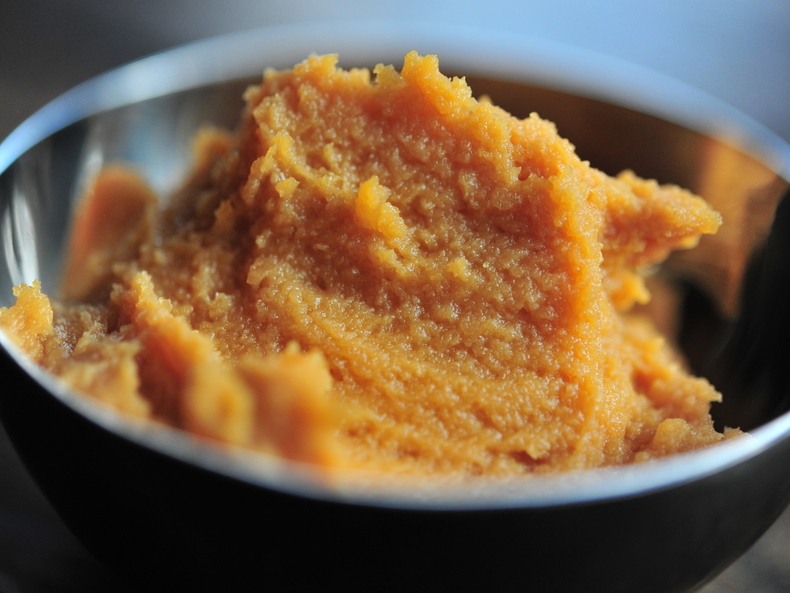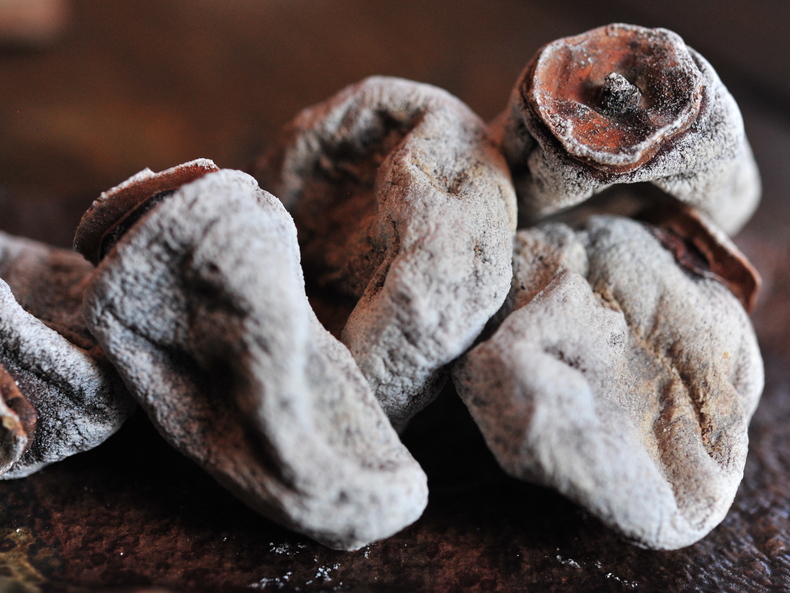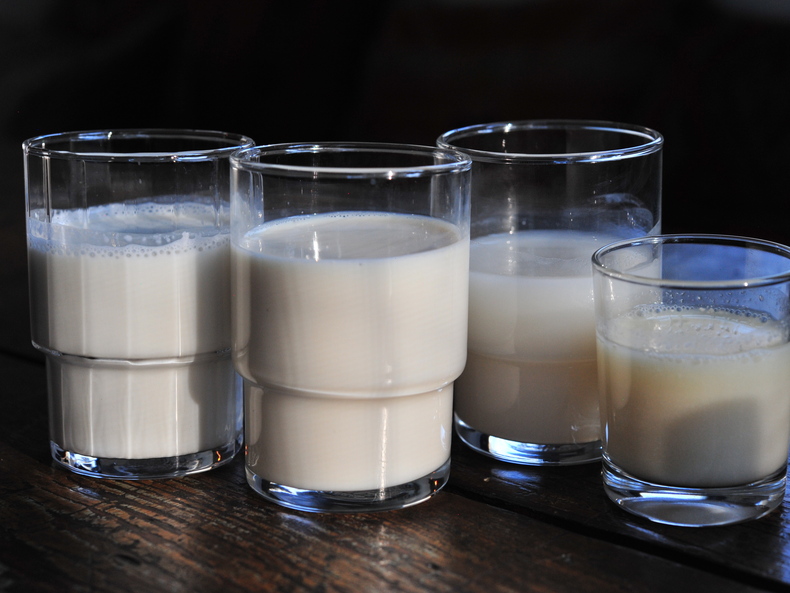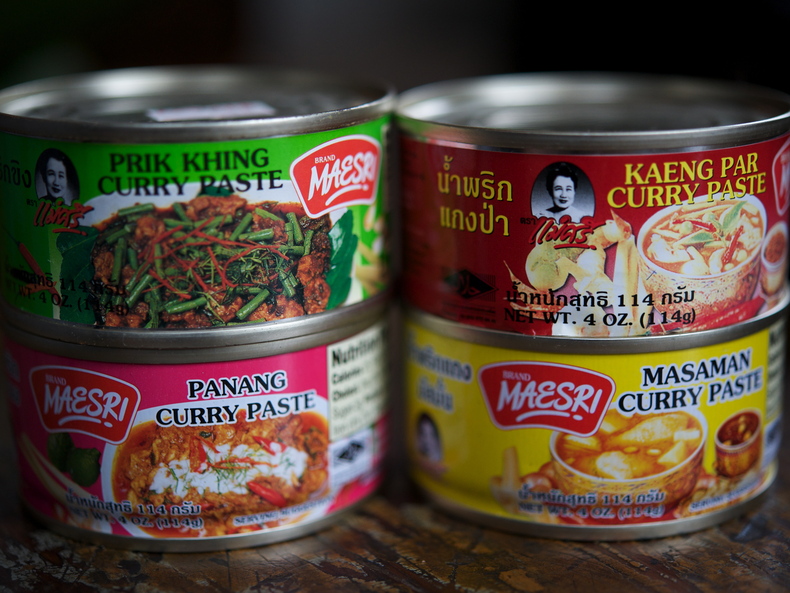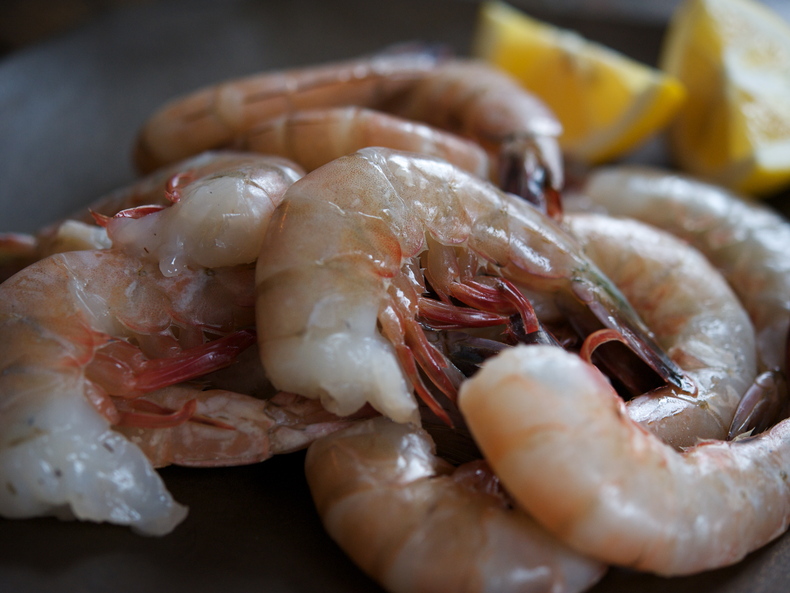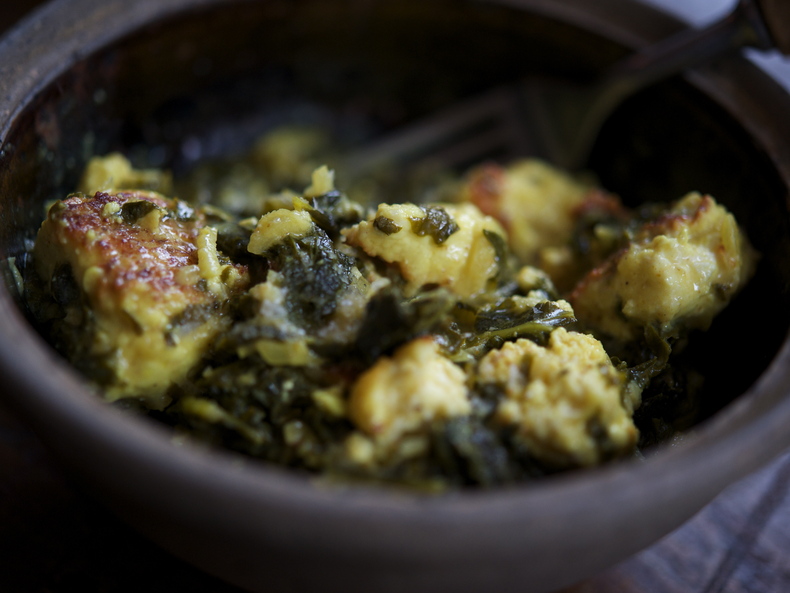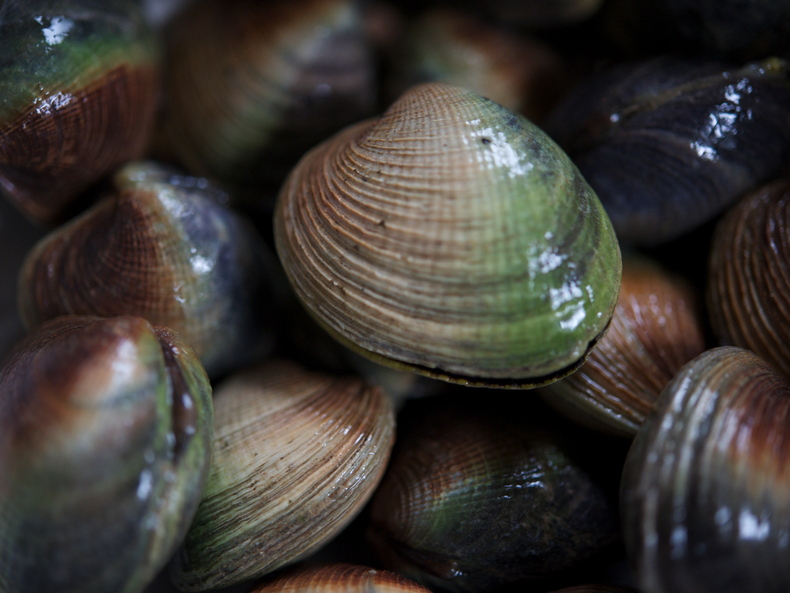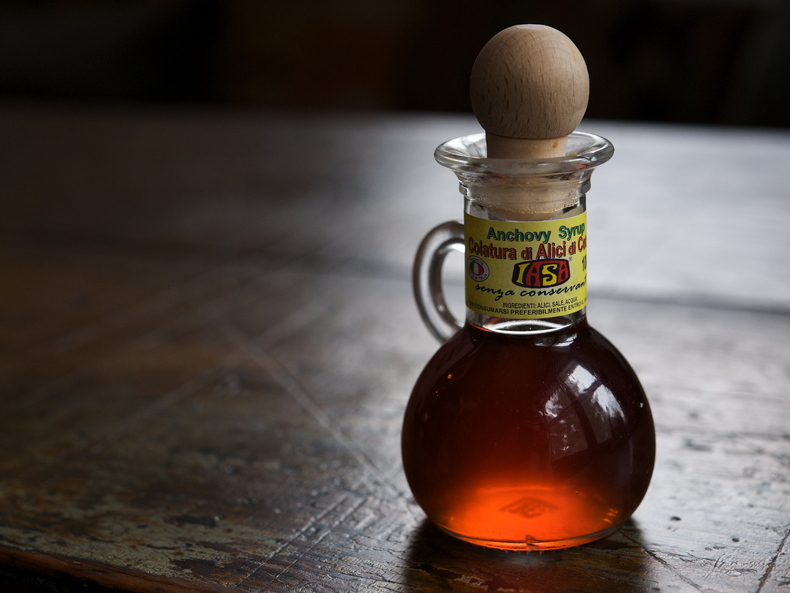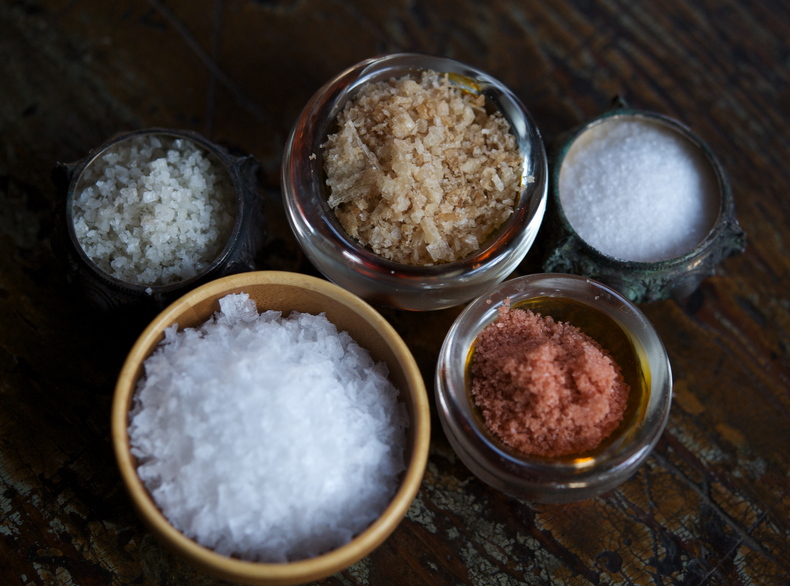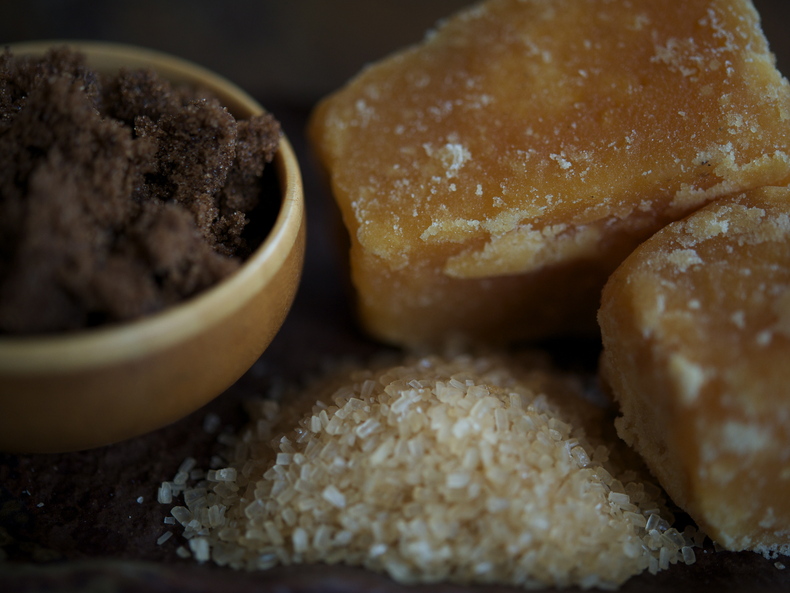Eating
2.26.10 Miso Hungry
Not sure how many of you read New York magazine, but I wanted to point out that we scooped them this week! (Did I say "we"? I guess I mean me, and of course, you, gentle reader.) They featured a round-up of salts that followed on the heels of mine, and I was pleased to note that food critic Adam Platt's favorite is the same: Maldon sea salt. This whole round-up idea seems to be a hit around here, so I will plan to offer more. Next up, sometime in the near future: vinegars.Of late I have been obsessed with the notion of creating a miso-butterscotch pudding. You can imagine just by looking at that photo of miso, above, how these two luscious flavors might go well together, right? I need an afternoon to putter around in the kitchen and develop this recipe; hopefully some time will free up soon. I'm betting most of you don't eat much miso, but I think you'd really like it. It's produced by fermenting soy beans (or rice, barley, buckwheat and even hemp) with salt and a fungus (koji), and the resulting flavor is variously described as salty, sweet, earthy, fruity and savory. (Hello, umami?) There are different types of miso—red, white, yellow, mixed—and they are all subtly different. Generally, yellow miso is slightly sweete; red miso is stronger and saltier; and white, commonly used for miso soup, is the most delicate. Apparently some of the nutrition in miso—including zinc, phosphorus, manganese, protein and copper—is destroyed through cooking, so it's often stirred into dishes late in the game. I'm sure you've had miso soup, right? A dashi broth with the paste stirred in at the end. Recently on Food52, someone submitted a recipe for oatmeal with miso stirred in after cooking. There are quite a few ways to incorporate this versatile seasoning—spread it on a sandwich, mix it into salad dressing, into rice, even into mashed potatoes. I recently posted a recipe for short ribs with miso. It's actually quite versatile, and can lend its earthy, salty goodness to many foods beyond Asian cuisine. Stay tuned for the miso-butterscotch pudding, but meanwhile here are a couple of easy ways for you to try it.
Read More...
Twitter @glutton4life
2.25.10 Strange Fruit
Despite what they may look like (withered breasts? moldy mushrooms?) these are actually dried persimmons—hachiyas, I think, because of their pointy ends. I picked them up at Mitsuwa, the Japanese market in New Jersey. Having recently snacked on some delicious dried persimmons from the farmer's market in Santa Monica, I was inspired to experiment with these. Right now, they're gently simmering on the stove with some dried tart cherries in a broth of orange juice and honey. (Spiked with a little cardamom, of course.) I'll let you know how they turn out. In the meantime, I'm having my breakfast of creamy sheep's milk yoghurt with some poached prunes and a few of those candied kumquats that first made their appearance alongside the burnt-orange ice cream. I am in heaven. I have loved prunes since childhood and fail to understand why they have been relegated to the geriatric set. The California Prune Counsel even started this big campaign to call them "dried plums." Which is, of course, what they are, but still. What's not to like? Prunes are essentially raisins, only bigger, meatier and more deeply flavorful. But even if you don't care for prunes, this is the season for delicious compotes made from dried fruits. Rather than buying flavorless, out-of-season fruits from Chile or wherever, consider turning to the more local dried bounty: apples, nectarines, apricots, cherries, prunes, raisins, dates, figs, etc. Any combination of these, poached in water to cover, reconstitutes into a soft, luscious tangle of sweet flavors.
Read More...
Read More...
2.22.10 Got Milk?
If you do, you may also have gas, bloating, sour stomach or frequent breakouts, especially around your chin. This is another of my "alternative round-ups." I already raved about goat's milk to you here, but I'd like to tell you about some other options in case you've got the dairy blues. All four milks you see above—hemp, soy, rice and almond—are available in organic boxed versions that are conveniently shelf-stable and thus easy to keep on hand. (They are vegan, too, but don't let that put you off if it's something you equate with Birkenstock-wearing, hairy-armpitted hippies. I grew up in Santa Cruz, so I don't share your hang-ups, man.) I usually have one or all of these milks open at a time, and I rotate them and use them in different ways. Have I mentioned the important of consuming a rich diversity of foods? That habit of eating the same thing, day in and out, even if it's "healthy," is not smart. Variety in all things (except your sex partners, maybe) is optimal.
Read More...
Read More...
2.21.10 Curry in a Hurry
These are the cans of Maesri Thai curry paste that I have written about before. They save you so much time and you'll sacrifice scarcely anything in terms of flavor or quality. They are free of artificial ingredients and preservatives, and their 15 varieties very faithfully replicate both traditional and more unusual curries, from green to red. (The masaman curry paste, for instance, contains garlic, sugar, soybean oil, dried red chiles, tamarind juice, shallots, salt, lemongrass, coriander, cumin, cardamom, cinnamon, bay leaves, galangal, cloves, kaffir lime and citric acid.) My friend Andrée recently appealed to me for some advice on the menu for a dinner party she was hostessing for 10 friends, and a delicious masaman curry was my first thought. With sticky rice and a sweet-tart cucumber salad, this dish makes a simple but slightly exotic meal that few can resist. For dessert, I suggested an easy and supremely refreshing combination of fresh pineapple with grated ginger, chopped mint and lime juice.
Read More...
Read More...
2.20.10 My 100th Post
That's right, 100 notches on my blogging bedpost. Although gluttonforlife launched on Christmas Eve, I had been accruing posts for quite a while before that while we worked on the design. If you look back in the archives, you may run across my recipe for Spicy Shorties, another of my concoctions singled out on Food52's editors' picks this week. It's always an honor to be included among the many talented chefs and interesting recipes in that diverse coking community. I hope you've been enjoying the blog thus far, and always welcome your comments and requests. As Sandra Bernhard so eloquently put it, without you, I'm nothing.But, in the grand scheme of things—and I'm in this for the long haul—100 posts is just a drop in the bucket. So there will be no recipe for a torchon of foie gras here today. I'm saving the lemon soufflé for a truly special occasion. I seem to be on a bit of a seafood roll (watch your mercury intake!), so I'll stay in that vein with this easy dish of shrimp, onions and saffron. I was first served this in the home of a friend in Spain, and I remember being impressed with its simplicity, its intensity of flavor and its beautiful yellow color. It's also reminiscent of my mother's shrimp scampi, a dish requested by my sister Sarita on her birthday every year. It goes well with crusty bread (a whole wheat baguette?), or try serving it with some brown basmati rice to soak up the juices. And a glass of icy Sancerre, of course.
Read More...
Read More...
2.20.10 The Saag-a Continues
If you've come across fresh paneer at the market, or been bold and tried making your own, a dish of saag is a wonderful way to use those pillowy cubes of creamy cheese. Although we frequently see it made with spinach, saag is actually any dish of spiced, stewed greens with a bit of yoghurt and cream or buttermilk stirred in. As in India, you can use any combination of greens you want, including mustard greens, chard, kale and collards. I like to leave the greens on the toothier side, so the dish is a bit less like baby food, but make it however you like. You can enrich it with cream, although I like the tangy taste you get from buttermilk and yoghurt (and they have fewer calories). I imagine you could play around with soy or hemp milk. This recipe calls for garam masala, which is a classic blend of ground spices. Almost all Indian cooks have their own version, and it can vary greatly from one region to another. True to the spirit of any curry, you can tweak the ingredients and proportions to suit yourself. If you don't have paneer, you can try using cubes of firm tofu, chunks of fried potato, or even cooked chickpeas for this dish. It won't be the same, but it will get you in the ballpark.
Read More...
Read More...
2.18.10 Cockles (& Mussels)
I've been in Minneapolis for work the past couple of days. Staying at a rather nice boutique hotel, The Chambers, that was recently acquired by Starwood. It's known as "the art hotel," because it's actually full of paintings and installations by "real" artists. The work in my room, however, is nothing to write home about. Had some lovely mussels here today. I once threw up out the door of a cab while driving up West Broadway, after having eaten a bad mussel at Caroline's comedy club in the seaport. This was sometime in the late 80s, but I still have a deep mistrust of these bivalves. They can be strangely murky and unpleasantly chewy. But ignoring the siren's call of the thin-crust pizza, I ordered a large bowl of the creatures. They arrived, plump and velvety soft, swimming in a creamy broth, scented with wine and garlic. WHAT'S WRONG WITH THAT? Not a thing. With these and a crisp green salad, I was happy. The meal put me in mind of another business trip, this one to Seattle, where I dined on a delicious bowl of Manila clams in a green coconut curry. And that reminded me that I've been meaning to share with you this wonderful recipe from Casa Mono, a Mario Batali side project where they serve delicious Spanish-influenced small plates.
Read More...
Read More...
2.18.10 Something Fishy
Have you discovered colatura di alici, an amber elixir of anchovy made around Italy's Amalfi coast for the last 2,000 years? Slow Food International has officially declared it a "protected" ingredient. (I ordered my first bottle online here.) When anchovies are salted for curing, they’re layered in wooden barrels, then pressed and weighted down. From small holes in the barrels drips this salty, funky syrup—thus the word colatura, from colare, “to drip” in Italian. Somehow, although more concentrated, it’s a bit less overtly fishy than anchovies. And it’s not quite as rank or muddy (or old gym sock-y) as Asian fish sauce—an essential pantry item, by the way. It's the modern version of garum, a fermented fish liquid (sometimes made from just their blood and guts) that was a sort of salt substitute in ancient Rome. The process was so smelly that production was apparently limited to outside the city walls!
Read More...
Read More...
2.15.10 Worth My Salt
I love this expression and its somewhat arcane origins. Salt once had such value that wages were paid in it. I, for one, could not live without the stuff. Having taken you through alternatives to sugar yesterday, I suppose the correct symmetry would have me talking about salt substitutes here, such as they are—soy sauce or even Mrs. Dash, I suppose. But instead I'm going to wax lyrical about my favorite salts. Oh, come off it, you're saying, right? Once it hits your tongue, one salt's the same as the next. Not so. Both texture and taste can vary quite a bit from one salt to another. There's always kosher on hand in my kitchen but it's relegated to the back of the cupboard. I cook with fine sea salt and use all types of flavored and finishing salts to accent dishes. Call me a salt snob, if you will. I'll take it as a compliment.
Read More...
Read More...
2.14.10 Sweet On You
I must confess, I have something of a sweet tooth. I can remember giggling over a box of See's candies with my (diabetic!) grandfather as we stuffed our mouths with chocolate. But I now know sugar is not really good for me. It causes inflammation which I experience as joint aches, and it makes my skin break out. Why? Refined sugar raises the insulin level in your blood and this depresses the immune system. This, in turn, compromises your ability to fight disease. It can cause weight gain since insulin promotes the storage of fat. Refined sugar contains no vitamins or minerals so in order for it to be metabolized it draws on the body's reserve of vitamins and minerals. When these reserves are depleted, metabolization of cholesterol and fatty acid is impeded, contributing to higher LDLs (harmful cholesterol) and promoting obesity due to higher fatty acid storage around the organs. Sugar consumption is also associated with copper deficiency, periodontal disease, diabetes, coronary heart disease, pathological changes to the liver and pancreas, hormonal imbalance, fluid retention, headaches, and on and on. Do you need more reasons to decrease your sugar intake? I’m not telling you to never again enjoy something sweet, but to consider eradicating white sugar in favor of these healthier options. These, too, should be eaten in moderation (yes, that again!)...
Read More...
Read More...






